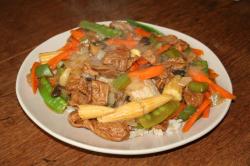Sometime this past summer I made an interesting discovery in the international aisle of the local Food-Coop, Bloomingfoods — Seitan in a can. What is seitan you might ask? It is wheat gluten. And what is wheat gluten? It is the part of wheat that makes bread stick together. Glutinous means sticky, and that is exactly what gluten does in bread. Without gluten, all the carbon dioxide that yeast produces when it is eating the sugars would simply evaporate, but the gluten in the wheat binds the flour together, and causes the air to get trapped, making little bubbles, which makes your bread light and fluffy. Other grains have gluten too, but wheat has the most by far.
If you get rid of the rest of the wheat and just leave the gluten, then you get a very sticky dough, which can be kneaded and cut into any shape you desire. Then the gluten is boiled, frequently in some sort of seasoned water, and then can be eaten, or can be further sauteéd, or baked. Seitan is 100% protein, and has a very nice texture which is surprising like meat. Lots of the commercially available meat substitutes contain seitan or wheat gluten, particularly in asian cooking (The Chinese invented it a long time ago). The only down side to seitan is that it is quite expensive. While living in Ann Arbor, I sometimes bought “Fajita strips” at the People’s Food Co-op, which were obviously made locally in someone’s kitchen, based on the ziploc bag and homemade label packaging. Boy were they tasty! Unfortunately, they cost about $5 for 12 oz. Needless to say, I was intrigued when I found seitan in a can for less than $2! Intrigued, but also skeptical. But as it turns out, it is very tasty. It can be a bit oily, so if you are making a stirfry, you might want to go light on the oil, or even drain the oil from the seitan to fry your vegetables. We have been able to find seitan in a can in a variety of flavors and shapes at the Co-op and at Asian grocery stores. Try it out!
